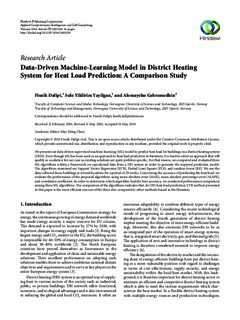| dc.contributor.author | Dalipi, Fisnik | |
| dc.contributor.author | Yildirim, Sule | |
| dc.contributor.author | Gebremedhin, Alemayehu | |
| dc.date.accessioned | 2020-03-05T10:00:31Z | |
| dc.date.available | 2020-03-05T10:00:31Z | |
| dc.date.created | 2016-05-18T09:57:33Z | |
| dc.date.issued | 2016 | |
| dc.identifier.citation | Applied Computational Intelligence and Soft Computing. 2016, 2016 . | nb_NO |
| dc.identifier.issn | 1687-9724 | |
| dc.identifier.uri | http://hdl.handle.net/11250/2645427 | |
| dc.description.abstract | We present our data-driven supervised machine-learning (ML) model to predict heat load for buildings in a district heating system (DHS). Even though ML has been used as an approach to heat load prediction in literature, it is hard to select an approach that will qualify as a solution for our case as existing solutions are quite problem specific. For that reason, we compared and evaluated three ML algorithms within a framework on operational data from a DH system in order to generate the required prediction model. The algorithms examined are Support Vector Regression (SVR), Partial Least Square (PLS), and random forest (RF). We use the data collected from buildings at several locations for a period of 29 weeks. Concerning the accuracy of predicting the heat load, we evaluate the performance of the proposed algorithms using mean absolute error (MAE), mean absolute percentage error (MAPE), and correlation coefficient. In order to determine which algorithm had the best accuracy, we conducted performance comparison among these ML algorithms. The comparison of the algorithms indicates that, for DH heat load prediction, SVR method presented in this paper is the most efficient one out of the three also compared to other methods found in the literature. | nb_NO |
| dc.language.iso | eng | nb_NO |
| dc.publisher | Hindawi | nb_NO |
| dc.relation.uri | http://www.hindawi.com/journals/acisc/2016/3403150/ | |
| dc.rights | Navngivelse 4.0 Internasjonal | * |
| dc.rights.uri | http://creativecommons.org/licenses/by/4.0/deed.no | * |
| dc.title | Data-driven Machine Learning Model in District Heating System for Heat Load Prediction: A Comparison Study | nb_NO |
| dc.type | Journal article | nb_NO |
| dc.type | Peer reviewed | nb_NO |
| dc.description.version | publishedVersion | nb_NO |
| dc.source.pagenumber | 11 | nb_NO |
| dc.source.volume | 2016 | nb_NO |
| dc.source.journal | Applied Computational Intelligence and Soft Computing | nb_NO |
| dc.identifier.doi | 10.1155/2016/3403150 | |
| dc.identifier.cristin | 1355960 | |
| dc.description.localcode | Copyright © 2016 Fisnik Dalipi et al. This is an open access article distributed under the Creative Commons Attribution License, which permits unrestricted use, distribution, and reproduction in any medium, provided the original work is properly cited. | nb_NO |
| cristin.unitcode | 194,63,30,0 | |
| cristin.unitcode | 194,64,94,0 | |
| cristin.unitname | Institutt for informasjonssikkerhet og kommunikasjonsteknologi | |
| cristin.unitname | Institutt for vareproduksjon og byggteknikk | |
| cristin.ispublished | true | |
| cristin.fulltext | original | |
| cristin.qualitycode | 1 | |

